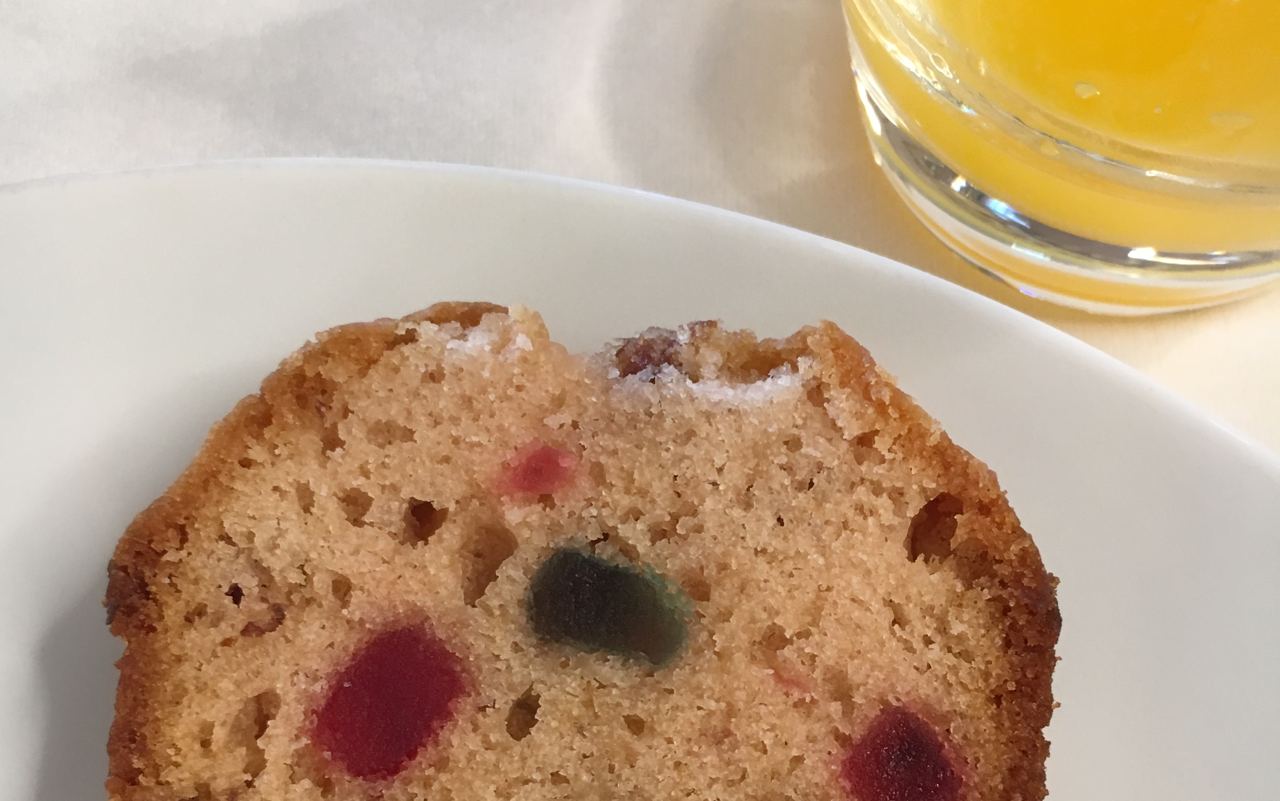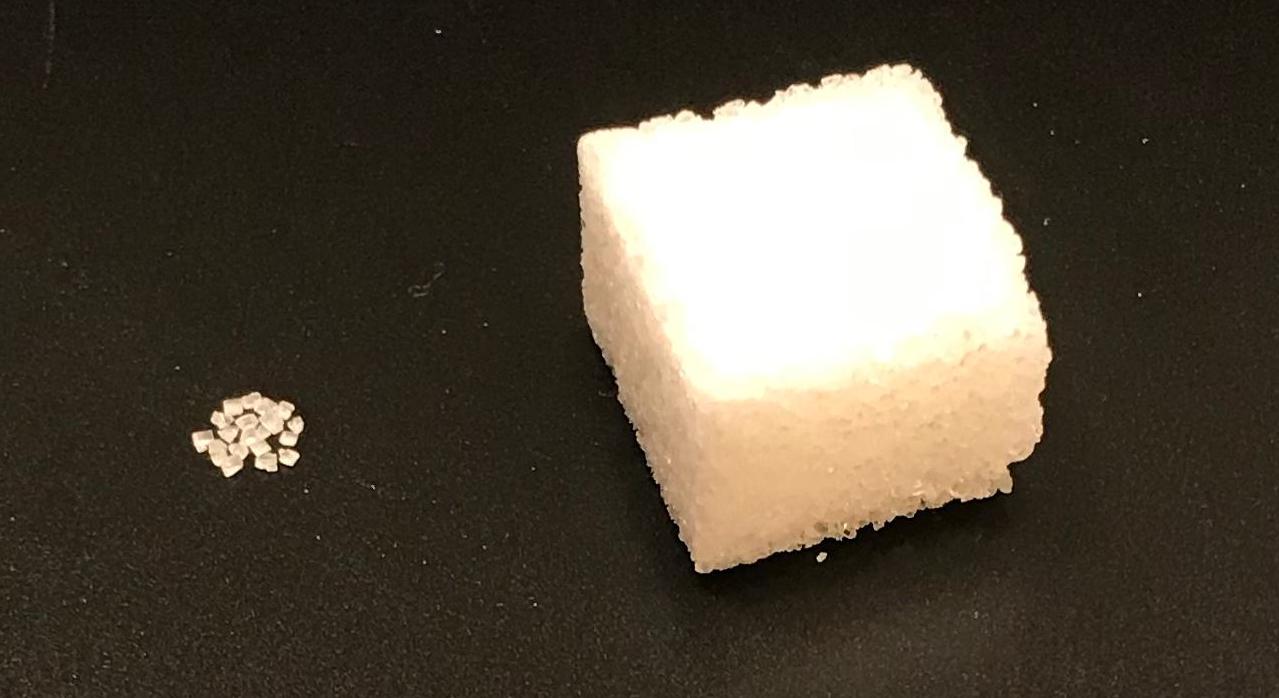Common misconceptions about sorbitol intolerance
04/15/2020 Food Intolerances
When you’re researching sorbitol intolerance online, you‘ll probably encounter a lot if unreliable information. We give you an overview about the most important facts and clear up some common misconceptions.

Sorbitol is a sugar alcohol that naturally occurs in many types of fruit and vegetables, where it serves as a precursor for the sugar synthesis. We consume it in small quantities with our food all the time.
Because it usually only occurs in small amounts in natural food, our intestinal system is not equipped to digest high quantities of sorbitol, which belongs to the group of FODMAPs, i. e. carbohydrates that are poorly absorbed by the body. Most sugar alcohols have a highly laxative effect even for healthy people.
However, if you experience digestive problems after consuming only a couple of grams, you might suffer from sorbitol malabsorption or intolerance.
And this is where the problem begins: Sorbitol and other sugar alcohols are very interesting to the food industry, since they absorb water and thus prevent the dehydration of packaged food. This is how products like packaged cakes stay moist and fluffy. The same ingredients also work as sugar replacements in some sugar-free or sugar-reduced foods, because they don't cause the blood sugar level to rise.
If you have ever snacked on too many cherries in summer, you know how uncomfortable the consequences can be. The symptoms of sorbitol intolerance are very similar, but are caused by much lower amounts. Depending on the consumed dose they can range from minor flatulence, belly ache and loose stools to severe diarrhea.
The reason for this lies in the hygroscopic effect of sugar alcohols. If large amounts of undigested sugar alcohols reach the colon, they cause an unpleasant chain reaction. Sorbitol draws water from its environment, increasing the stool volume. At the same time intestinal bacteria ferment the sorbitol, often producing harmful metabolic products and digestive gases, which further stresses the intestine. The symptoms are similiar to other carbohydrate malabsorptions, like lactose intolerance.
If you suspect that your digestive problems are caused by sorbitol in food, you should see a gastroenterologist. They can administer a hydrogen breath test, where you drink a solution containing 5 to 10 grams sorbitol on an empty stomach. The fasting before the test enables the solution to quickly pass through the stomach and the small intestine, where part of the sorbitol is absorbed. After 90 to 150 minutes the rest reaches the large intestine, where the bacteria of the intestinal flora get to work on fermenting the sugar alcohol. During this entire process the pyhsician measures the level of hydrogen in the patient's breath.
Hydrogen is only produced when there's a bacterial fermentation of carbohydrates in the intestine. The gas reaches the bloodstream through the intestinal mucosa and is exhaled via the lungs. A high concentration of hydrogen in the breath indicates that the sorbitol is not completely absorbed by the intestine. If digestive problems occur after the test, everything points to a sorbitol intolerance.
The sorbitol breath test is easy to do and non-invasive, but it has one big disadvantage: Even in healthy people, an amount of 5 grams already leads to a malabsorption in 50% of the cases. 20 grams cause issues in over 80%.
Regardless of the test result you should continue to keep a nutrition diary and check if your symptoms really disappear after avoiding sorbitol. If that's not the case, talk to your doctor again to make sure you receive the correct diagnosis.
Sorbitol mostly occurs in certain fruit and to a lesser degree in some vegetables.
▲ Table 1: Natural sorbitol content in selected fruit
Every product that contains fruit with sorbitol also contains sorbitol, e. g. juices, jams or fruit desserts. Naturally occurring sorbitol does not have to be declared in the ingredients list!
When sorbitol is added to industrially manufactured foods as a sweetener or a humectant, it has to be declared explicitly as sorbitol or E 420.
Other sugar alcohols
There are other sugar alcohols besides sorbitol that can be problematic for people with a sorbitol intolerance when consumed in high amounts, e. g. mannitol (E 421), isomalt (E 953), malitol (E 965), lactitol (E 966), xylitol (E 967), and erythritol (E 968).
The following foods often contain sorbitol:
At the same time many foods that are said to have a high sorbitol content don't actually contain any or only insignificant traces.
The following products DO NOT contain problematic amounts of sorbitol:
* Sugar-free drinks usually aren't sweetened with sorbitol, since the necessary amount would also exceed the tolerance level of healthy people (the sweetening power of sorbitol isn't as strong as that of sugar). Normally sugar-free drinks contain sweeteners that are more easily tolerated, like cyclamate, acesulfame K or aspartame.
Unfortunately there is a lot of false information online, which causes much uncertainty. As soon as you start taking a closer look at the topic, you notice that many websites copy unproven facts from other sites, so that incorrect content is rapidly spread and also stays online for a long time. To clear up this kind of common misconceptions was actually one of the main reasons to develop our app Food Intolerances.
We want to explain the problem using beer as an example. Sorbitol is not a by-product of the alcoholic fermentation, but it can come into the beer in trace amounts through the yeast where sorbitol derivatives are used as stabilizers. However, we are talking about minimal amounts in the range of less than 2 mg/100 ml. According to many websites beer should be strictly avoided, because it contains sorbitol.
That means that one glas of beer (300 ml) contains 6 mg sorbitol – not really all that much! As a comparison: One nectarine contains around 1 g of sorbitol, which is an amount many people with sorbitol intolerance are just about able to eat. Therefore you would have to drink 166 glasses of beer to reach the same level of sorbitol as in a nectarine. So calling beer a high-sorbitol food doesn't really make any sense (see figure 1). The same is true for bread that can also contain trace amounts of sorbitol originating from the yeast.*

Figure 1: Sorbitol content of 100 ml beer (on the left) compared to that of a small pear (on the right).
It's true that beer can cause problems for a lot of different food intolerances, but this doesn't have anything to do with its sorbitol content, which is much too low to matter. And it's a misunderstanding that you have to completely avoid sorbitol when you have a sorbitol intolerance. What is important is to watch out for how much sorbitol you eat. Also, people with IBS symptoms in general don't tolerate alcoholic drinks very well – if you want more information about this topic, please read our article about possible causes for irritable bowel syndrome.
* The situation is different if you are allergic to sorbitol-derived compounds, e.g. sorbitan sesquioleate and sorbitan monooleate. In case of an allergy to these compounds you should keep in mind that they can be found in beer, bread and any other leavened food.
Back to blog
References:
M. Grembecka et al., Simultaneous separation and determination of erythritol, xylitol, sorbitol, mannitol, maltitol, fructose, glucose, sucrose and maltose in foodproducts by high performance liquid chromatography coupled tocharged aerosol detector, Microchemical Journal 117 (2014), 77–82
G. Arfelli et al., Characterisation of brewpub beer carbohydrates using high performanceanion exchange chromatography coupled with pulsed amperometricdetection, Food Chemistry 142 (2014), 152–158
S. Cortacero-Ramírez et al., Analysis of beer components by capillary electrophoretic methods, Trends in Analytical Chemistry 22(7+8) (2003), 440–455
R. Andersen et al., Separation and determination of alditols and sugars by high-pH anion-exchange chromatography with pulsed amperometric detection, Journal of Chromatography A, 897 (2000), 195–204
https://de.wikipedia.org/wiki/Wasserstoffatemtest (accessed 08/2019)
K. Saussy et al., Allergic Contact Dermatitis From Sorbitans in Beer and Bread, Cutis. 104 (2019), 184–186

What is sorbitol intolerance?
Sorbitol is a sugar alcohol that naturally occurs in many types of fruit and vegetables, where it serves as a precursor for the sugar synthesis. We consume it in small quantities with our food all the time.
Because it usually only occurs in small amounts in natural food, our intestinal system is not equipped to digest high quantities of sorbitol, which belongs to the group of FODMAPs, i. e. carbohydrates that are poorly absorbed by the body. Most sugar alcohols have a highly laxative effect even for healthy people.
However, if you experience digestive problems after consuming only a couple of grams, you might suffer from sorbitol malabsorption or intolerance.
And this is where the problem begins: Sorbitol and other sugar alcohols are very interesting to the food industry, since they absorb water and thus prevent the dehydration of packaged food. This is how products like packaged cakes stay moist and fluffy. The same ingredients also work as sugar replacements in some sugar-free or sugar-reduced foods, because they don't cause the blood sugar level to rise.
Symptoms of sorbitol intolerance
If you have ever snacked on too many cherries in summer, you know how uncomfortable the consequences can be. The symptoms of sorbitol intolerance are very similar, but are caused by much lower amounts. Depending on the consumed dose they can range from minor flatulence, belly ache and loose stools to severe diarrhea.
Why do we care so much about this topic?
 We have been developing our price-winning "Food Intolerances" app since 2011 and we are happy to share our knowledge with you. Check it out:
We have been developing our price-winning "Food Intolerances" app since 2011 and we are happy to share our knowledge with you. Check it out:
The reason for this lies in the hygroscopic effect of sugar alcohols. If large amounts of undigested sugar alcohols reach the colon, they cause an unpleasant chain reaction. Sorbitol draws water from its environment, increasing the stool volume. At the same time intestinal bacteria ferment the sorbitol, often producing harmful metabolic products and digestive gases, which further stresses the intestine. The symptoms are similiar to other carbohydrate malabsorptions, like lactose intolerance.
How is sorbitol intolerance diagnosed?
If you suspect that your digestive problems are caused by sorbitol in food, you should see a gastroenterologist. They can administer a hydrogen breath test, where you drink a solution containing 5 to 10 grams sorbitol on an empty stomach. The fasting before the test enables the solution to quickly pass through the stomach and the small intestine, where part of the sorbitol is absorbed. After 90 to 150 minutes the rest reaches the large intestine, where the bacteria of the intestinal flora get to work on fermenting the sugar alcohol. During this entire process the pyhsician measures the level of hydrogen in the patient's breath.
Hydrogen is only produced when there's a bacterial fermentation of carbohydrates in the intestine. The gas reaches the bloodstream through the intestinal mucosa and is exhaled via the lungs. A high concentration of hydrogen in the breath indicates that the sorbitol is not completely absorbed by the intestine. If digestive problems occur after the test, everything points to a sorbitol intolerance.
What are the limitations of the hydrogen breath test?
The sorbitol breath test is easy to do and non-invasive, but it has one big disadvantage: Even in healthy people, an amount of 5 grams already leads to a malabsorption in 50% of the cases. 20 grams cause issues in over 80%.
Note: Nobody can tolerate big amounts of sorbitol. A positive result of the breath test is only relevant if the consumption actually leads to problems.
Regardless of the test result you should continue to keep a nutrition diary and check if your symptoms really disappear after avoiding sorbitol. If that's not the case, talk to your doctor again to make sure you receive the correct diagnosis.
Which natural foods contain sorbitol?
Sorbitol mostly occurs in certain fruit and to a lesser degree in some vegetables.
| Food | Sorbitol content |
|---|---|
| Prunes (a handful) | 7 g |
| Pear (one) | 4 g |
| Plums (two) | 3,6 g |
| Apricots (three) | 1,4 g |
| Nectarine (one) | 1 g |
| Apple (one) | 0,6 g |
Every product that contains fruit with sorbitol also contains sorbitol, e. g. juices, jams or fruit desserts. Naturally occurring sorbitol does not have to be declared in the ingredients list!
Industrially manufactured foods with sorbitol
When sorbitol is added to industrially manufactured foods as a sweetener or a humectant, it has to be declared explicitly as sorbitol or E 420.
Other sugar alcohols
There are other sugar alcohols besides sorbitol that can be problematic for people with a sorbitol intolerance when consumed in high amounts, e. g. mannitol (E 421), isomalt (E 953), malitol (E 965), lactitol (E 966), xylitol (E 967), and erythritol (E 968).
The following foods often contain sorbitol:
- chocolates
- chocolate with cream filling
- cough drops
- chewing gum
- ginger bread
- packaged cakes, cupcakes or muffins
- ice cream on a stick
- chewy candy with fruit flavor
At the same time many foods that are said to have a high sorbitol content don't actually contain any or only insignificant traces.
The following products DO NOT contain problematic amounts of sorbitol:
- mustard
- mayonnaise
- milk chocolate or dark chocolate
- beer and wine
- vinegar
- yeast extracts
- sugar-free lemonades*
* Sugar-free drinks usually aren't sweetened with sorbitol, since the necessary amount would also exceed the tolerance level of healthy people (the sweetening power of sorbitol isn't as strong as that of sugar). Normally sugar-free drinks contain sweeteners that are more easily tolerated, like cyclamate, acesulfame K or aspartame.
Unfortunately there is a lot of false information online, which causes much uncertainty. As soon as you start taking a closer look at the topic, you notice that many websites copy unproven facts from other sites, so that incorrect content is rapidly spread and also stays online for a long time. To clear up this kind of common misconceptions was actually one of the main reasons to develop our app Food Intolerances.
Beer and sorbitol intolerance
We want to explain the problem using beer as an example. Sorbitol is not a by-product of the alcoholic fermentation, but it can come into the beer in trace amounts through the yeast where sorbitol derivatives are used as stabilizers. However, we are talking about minimal amounts in the range of less than 2 mg/100 ml. According to many websites beer should be strictly avoided, because it contains sorbitol.
That means that one glas of beer (300 ml) contains 6 mg sorbitol – not really all that much! As a comparison: One nectarine contains around 1 g of sorbitol, which is an amount many people with sorbitol intolerance are just about able to eat. Therefore you would have to drink 166 glasses of beer to reach the same level of sorbitol as in a nectarine. So calling beer a high-sorbitol food doesn't really make any sense (see figure 1). The same is true for bread that can also contain trace amounts of sorbitol originating from the yeast.*

Figure 1: Sorbitol content of 100 ml beer (on the left) compared to that of a small pear (on the right).
It's true that beer can cause problems for a lot of different food intolerances, but this doesn't have anything to do with its sorbitol content, which is much too low to matter. And it's a misunderstanding that you have to completely avoid sorbitol when you have a sorbitol intolerance. What is important is to watch out for how much sorbitol you eat. Also, people with IBS symptoms in general don't tolerate alcoholic drinks very well – if you want more information about this topic, please read our article about possible causes for irritable bowel syndrome.
* The situation is different if you are allergic to sorbitol-derived compounds, e.g. sorbitan sesquioleate and sorbitan monooleate. In case of an allergy to these compounds you should keep in mind that they can be found in beer, bread and any other leavened food.
Why do we care so much about this topic?
 We have been developing our price-winning "Food Intolerances" app since 2011 and we are happy to share our knowledge with you. Check it out:
We have been developing our price-winning "Food Intolerances" app since 2011 and we are happy to share our knowledge with you. Check it out:
Share article
Share article
Back to blog
References:
M. Grembecka et al., Simultaneous separation and determination of erythritol, xylitol, sorbitol, mannitol, maltitol, fructose, glucose, sucrose and maltose in foodproducts by high performance liquid chromatography coupled tocharged aerosol detector, Microchemical Journal 117 (2014), 77–82
G. Arfelli et al., Characterisation of brewpub beer carbohydrates using high performanceanion exchange chromatography coupled with pulsed amperometricdetection, Food Chemistry 142 (2014), 152–158
S. Cortacero-Ramírez et al., Analysis of beer components by capillary electrophoretic methods, Trends in Analytical Chemistry 22(7+8) (2003), 440–455
R. Andersen et al., Separation and determination of alditols and sugars by high-pH anion-exchange chromatography with pulsed amperometric detection, Journal of Chromatography A, 897 (2000), 195–204
https://de.wikipedia.org/wiki/Wasserstoffatemtest (accessed 08/2019)
K. Saussy et al., Allergic Contact Dermatitis From Sorbitans in Beer and Bread, Cutis. 104 (2019), 184–186
![[Blog]](../../rw_common/images/baliza_logo_retina.png)



